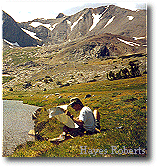| Planning Overview | Trail Descriptions | Stock Use | Hiking | Climbing | Special Use Areas |
| Planning Overview | Trail Descriptions | Stock Use | Hiking | Climbing | Special Use Areas |
How Do I Plan A Trip in Yosemite's Wilderness?
1. Think
about what type of wilderness experience you would like to have.  Learn more about the areas by using maps and specific
trail information. Learn more about the areas by using maps and specific
trail information.2. Once you have determined which trail you want to take, make sure you have all of the necessary equipment including the ten essentials every hiker should carry in his or her pack. Check the helpful information below concerning parking, transportation, equipment storage, backpackers campgrounds, bear canisters, and equipment rental or purchase locations. 3. If you plan on spending the night and camping in the wilderness, you are required to have a Wilderness Permit. Some areas of Yosemite are heavily impacted and must have special rules and regulations to aid in their preservation. Make sure to look at the Special Use Areas and note any that you may pass through and the special considerations of each area. If you are bringing stock, climbing a technical route, hiking with a large group, or hiking long distance (for example: the John Muir Trail) read the sections of additional information. 4. Before you arrive, check the weather and conditions for Yosemite and the surrounding areas. Be aware of inclement weather, high water, or high snowpack that may cover trails. Think about safety concerns and give someone an itinerary of your trip in case of an emergency.
|
|
Transportation
Transportation To and From Yosemite: Yosemite.com is a good source of information on trains, buses, etc. into and out of the park. Yosemite Area Regional Transportation System: YARTS provides year-round service daily from Merced to Yosemite Valley and seasonal service between Mammoth Lakes and Yosemite Valley (via Tuolumne Meadows) daily, among other areas. Yosemite Valley Shuttle: A free shuttle service is available in the east end of Yosemite Valley. The buses run approximately every 10 minutes in Summer (20 minutes in Winter) servicing all Valley campgrounds and most Valley trailheads. Glacier Point Bus: In the summer, a Glacier Point tour bus runs
several times each day from Yosemite Valley to Glacier Point and back. Many hikers choose
to take this trip one way and then hike back to Yosemite Valley. Check at the desk for
current prices and scheduled departure times. Tuolumne Meadows Shuttle: A free shuttle bus runs between Tioga Pass and Tenaya Lake daily from approximately July 1 through Labor Day weekend. Tioga Road Bus: Beginning approximately July 1 through Labor Day, there is a daily bus that runs from Yosemite Lodge to Tuolumne Meadows, and back on Highway 120 east. Arrangements can be made to be let off at any trailhead along the road. Check at the Yosemite Lodge tour desk or call (209)372-1000 for current prices and scheduled departure times.
|
|
Most trailheads have free parking areas where vehicles can be parked for several days. DO NOT STORE FOOD IN YOUR VEHICLE! Leave all food and drinks, cosmetics, and other items with a scent in a bear box. Other items resembling food must be stored in the trunk; if the vehicle does not have a trunk, the items may be left in the vehicle if they are covered. In Yosemite Valley, backpackers must park in the backpackers' parking area located between Curry Village and Happy isles. There are a number of parking areas in Tuolumne Meadows, White Wolf, Crane Flat, Hetch Hetchy, Glacier Point, and Wawona.
For Extra Gear: Limited storage is available in small lockers in Curry Village. The Wilderness Center, visitor centers, permit stations and ranger stations will not store food or equipment. Food Storage: There are food storage lockers in the Backpacker's Parking Lot in Yosemite Valley and by the Tuolumne Permit Station. There are boxes in the Backpackers' campgrounds in Yosemite Valley, Tuolumne Meadows, and Hetch Hetchy. These campgrounds are available to backpackers the night before or after an overnight wilderness trip. On an overnight trip into the wilderness, it is strongly recommended to carry a Bear Canister. See the section on bears and your food.
Backpackers' Campgrounds Walk-in campgrounds are available in the Tuolumne Meadows Campground, at Hetch Hetchy, and behind North Pines Campground in Yosemite Valley. Wilderness permit holders may spend one night before and one night after a wilderness trip in any one of these campgrounds. The cost is $3.00 per person per night. Reservations are not necessary.
Extra gear such as stove fuel, rope, food, first aid kits, etc. may be purchased at locations inside the park. Yosemite Village Sport Shop Curry Village Mountain shop Wawona Store Crane Flat Store Tuolumne Mountaineering School The mountain shops in Tuolumne Meadows (open in summer only) and at Curry Village in Yosemite Valley carry a selection of backpacking gear (i.e. tents, sleeping bags, etc.). A limited number of items are available to rent.
Be prepared for emergencies- carry a first aid kit and know how to use it. Please know and stay within your limitations to protect yourself and others from rescues which can be dangerous and expensive (you may even be charged for the cost of the rescue!). Rangers do not keep track of overdue hikers. It is your responsibility to make sure someone knows where you are going and when you are due back.
|
http://www.nps.gov/yose/wilderness/tripplanning.htm
File created 9/99 Hayes Roberts
Updated Friday, 05-Jan-01 12:18:30
Yosemite National Park Division
of Interpretation